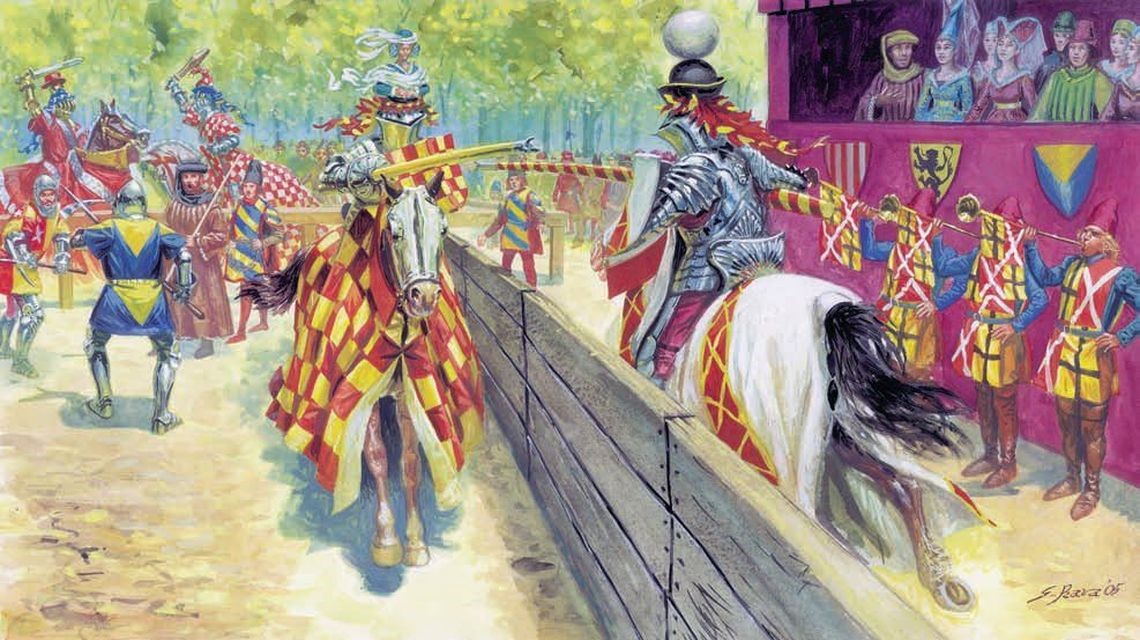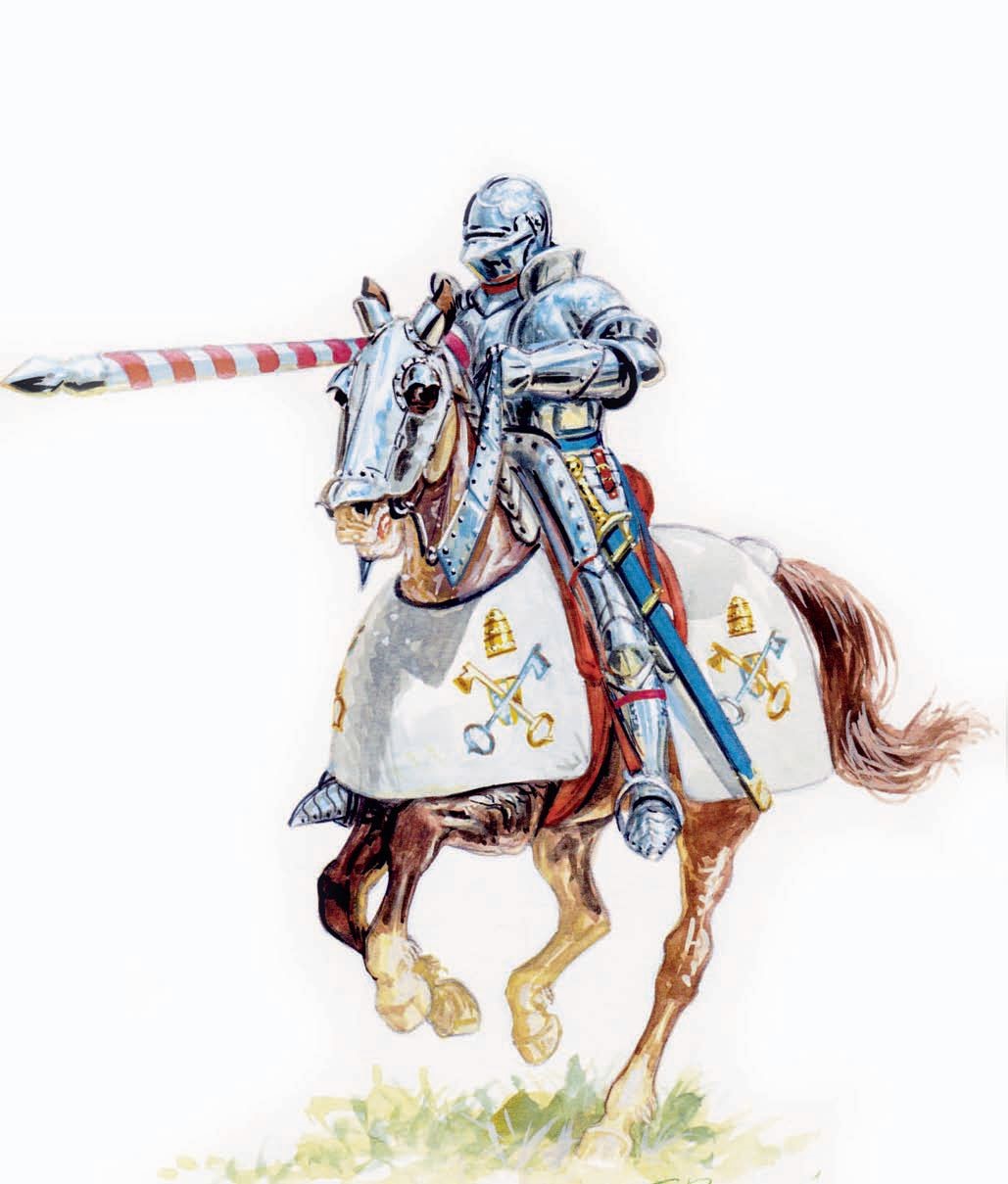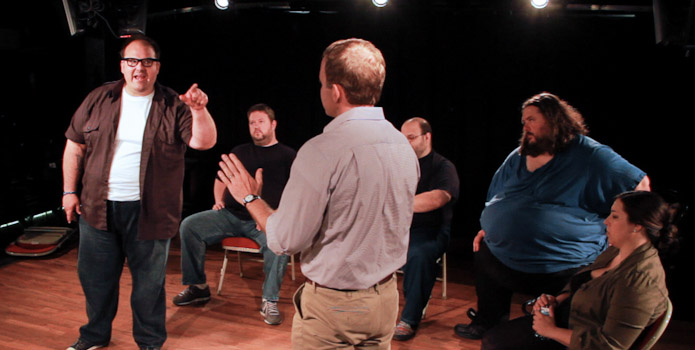Some of the most famous warriors of all time are medieval knights. Covered by the glory of the medieval battlefields and surrounded by a more mystical aura, the knights had, over time, an idealization and transformation into a success-worthy model, due to the principles of the chivalric code. The cavalry was always a specialized, elite weapon which only included those who had the ability to ride and fight at the same time and had the money to purchase and maintain some horses and specific equipment.
How did somebody become a medieval knight?
The medieval knight is an exclusively European creation of Christian (Catholic) origin. When talking about medieval knights, a clear distinction must be made between the military-religious orders during the Crusades and the “ordinary” European knights.
After the fall of the Roman Empire and the creation of various states on its ruins, a redevelopment of forces and capital transformations takes place on the continent. The power was no longer centralized, being divided among various local leaders, few of whom succeeding in imposing on wider territories, which later became kingdoms. Since the 8th century, we can again bring to the forefront the specialization of army jobs and weaponry by using horses in battles. Nevertheless, the equipment and the weaponry increased in price.
Between the 9th and the 11th century, in Europe, during the so-called “feudal anarchy”, a re-establishment of the military hierarchy in the West took place, a phenomenon stimulated by external threats – attacks in particular from bands of Saracens, Magyars and Vikings. Thus, elite military groups and brotherhood of knights are created around the great nobles and the monarch, in order to protect monasteries or communities from thieves or invaders.
In the nineteenth century, the social position of the knight was already very clear: he was a heavily armed rider, a weapons master he was part of the military and social elite, he was the vassal and suzerain of somebody, able to climb the Feudalism pyramid through deeds of courage, loyalty and bravery. The knight could live on the lord’s land, “demesne” or domain, even in the castle or on a land conceded by the lord. In exchange for the acquired domain, the knight had military debts. Since the 12th century, chivalry and nobility have become closely interrelated.
Probably the paladins of emperor Charlemagne, also known as Charles the Great, may be referred to as the first knights; they were sometimes known as the Twelve Peers and the most famous of them was Roland, the hero (and the victim) of Battle of Roncevaux Pass. These 12 paladins were riders who accompanied the Emperor to the war, following the model of the Knights of the Round Table in the Arthurian legend. The data about them is more mythological than historical.
Knights Code of Chivalry or the honor code of the knight. How it was created
Considering the endemic violence of the society of that time and the fact that people carrying weapons could commit any kind of abuse without being sanctioned or punished in any way, the Church decided to take action by imposing strict rules regarding the use of violence, even by forbidding the use of violence and threatening to excommunicate all those who commit acts of violence, especially against defenseless people. By doing so, the Church also reassured the bellicose nobles who wanted to expand their power and possessions.
This is how the actual knightly code of ethics was created: it was developed from the religious canons imposed by the Church, through self-sacrificing service for the Church, especially when it came to defending the poor and innocent.
Pope Gregory VII creates a new model of holy warrior – a miles Sancti Petri – there was only the concept of miles Christi (the soldier of Christ), a concept that included martyrs, priests, monks. The new concept aimed to include those who wanted to serve Christianity with a weapon in their hands. The occasion was well chosen, especially in the context of fighting against the Arabs in the Iberian Peninsula and against the European pagans in the Baltic Sea region. The ethics of the new type of knight were based on principles of bravery, prudence, wisdom, experience, group spirit, solidarity, fraternal friendship.
At the age of 7, most of the future knights, who came from noble or wealthy families, would be sent off to serve as a page; they were sent to a noble court, usually the suzerain’s court (nobleman, relative, or even the monarch’s court), where they were taught good manners, liberal arts, courtesy to ladies, general knowledge – They learned how to read, write and speak Latin and Greek, – how to serve the senior’s table, how to take care of the horses.
At the age of 14, they became a squire whose duties were to work for a knight. The knight trained them thoroughly in the art of war. Much of the instruction consisted in hunting, where the squire learned to shoot with bow and crossbow, even if he will never use these weapons in battle! If the squire was worthy, at about age 18-21, he was made a knight in a “dubbing” ceremony. usually before a battle, or after a battle, if he had won this honor with his weapon in his hand.
The Investiture of the Knight
The investiture of the knight required very clear rules and became, during the 12th-13th centuries – the classical period and the apogee of the institution of knighthood – a religious sacrament.
The knight shaved his beard and cut his hair and was given the symbols of his new status: the white tunic, which was a symbol of purity, the red robe, which was a symbol of red blood, shed by knights in defense of God’s holy law; white belt; the golden spurs, symbolizing the speed with which they will carry out their divine mission; red socks, symbolizing the earth they will return to; black shoes. He was touched on each shoulder with a sword or he was receiving a ritual military blow – the alapa militaris – with the right hand on his neck or on the back of his head the last blow in his life that he could receive without retaliation, meaning awakening from evil dreams, to the new life.
The new knight took a purifying bath, then a regenerating sleep; he awoke another man, a man of the holy army of Christianity, leaving completely behind his previous life. Some were spending the night in the chapel / church, praying with the sword on the altar. He was given knight weapons, which would be his comrades of battle, life and death from now on. They were given knight weapons, which would be their comrades of battle, life and death from now on.
The life of a knight
From that moment on, the knight’s life followed a different schedule: duels, instructions, fights, hunters, feasts and tournaments. The knight was basically a fighter and a solitary traveler, constantly seeking adventures, which were sources of enrichment and enlistment in various war expeditions.
Tournaments date back to 1100, and were regarded as sports and training, but also a good opportunity for some to publicly display their military skills, without any modesty. Just as in the ancient amphitheaters, the fights were supposed to entertain the audience – primarily, the lances or the spears had to shatter spectacularly, and the opponent had to be smitten to the ground. Tournament armors were way more elaborate than fight armors; they were more colorful, with various decorative elements, especially on the helmet, depicting prey or fantastic animals, or even the emblems of the combatants. The horses also had partial, very elaborate armor, especially for the head.
Tournaments were officially forbidden by the Papacy between 1130 and 1316, being seen as improper displays of violence. However, they continued unhindered in England, being legalized in 1194. At the end of the twelfth century, heralds and referees appeared, as well as the blazons, generalized in the 13th century.
Equipment, weapons, tactics
A knight’s equipment (armor and weapons) has undergone inherent changes over the centuries. The knight was basically a heavily equipped and armed fighter, protected by metal armor, which had the role and purpose of protecting the fighter against enemy blows, but at the same time providing him with great mobility. Stories on knights being hoisted into their saddles with a crane or armor weighing tens of kilos are pure inventions of the creators of cartoons and comedy, taken over without discernment and advised by the general audience and even by some historians. The art of designing and making armors progressed so, that a fully equipped knight could run and even tumble without being uncomfortable with the armor he wore.
Hand protections and metal gloves had mobile fingers so the fighter could use his palm and fingers normally. The head was protected by a metal helmet, which also protected the knight’s face. The patterns varied over time: initially, a chainmail shirt protected the knight’s body, later the metal plate armor, then the metallic cuirasses of the famous Gothic armor. Underneath the helmet and the armor the knight would wear a padded garment, as a protection between the metal and his own skin.
Over the armor, the knight would wear a tunic, generally a thigh-length tunic. The tunic could be embroidered with his. own coat of arms. In the case of the Crusaders, this tabard was longer, to protect them from the Sun of the Orient. Metal gloves also progressed over time, from one finger chainmail gloves to metallic five finger gloves, perfectly collapsible and useful in fight. Some knights wore metallic protection for thighs and calves.
As weapons, the knight wore a sharp double-edged sword, with a sharp point, and a shield – their shape varied: round, oval, rectangular, “kite” or ” triangular”. In his girdle he wore a long and double-edged dagger, just in case he loses his weapons in battle. Of course, the equipment “part” that was defining him as a knight was the saddled horse.
Without a horse and a saddle, the knight would have been a simple foot soldier, or infantryman. Caparisons were part of the horse armor known as barding, which was worn during war or tournament. Caparisons were frequently embroidered with the coat of arms of the horse’s rider or with other symbolic signs.
As a tactic, the knights were usually attacking from the sides of the army, towards the enemy, with their lances couched (held horizontally) and well placed against the enemy. The attack or the batch had the role of breaking the enemy formation, whether it was a cavalry or infantry formation; after this first impact, the lance became useless.
The struggle was now individual, each knight using the sword to kill or capture as many enemies as possible. During the European wars, the knights didn’t kill each other – it was more honorable to capture another knight who gave his word that he would send a certain amount of money to the one who captured him in battle. The Knight’s Honor worked every time.
Along with the knight, there were his shield bearer and possibly other armed escorts, depending on the rank and financial strength of the knight. To be recognized in battle, the coat of arms of each knight was on his shield, on the tabard, possibly on caparisons.
Fame and decay
A whole chivalry literature has been developed around the knights during the 13th-15th centuries, depicting laudably and didactically the courage and sacrifice of the knights, as well as their supposed love affairs. This literature, in the form of novels, poems or odes, became known throughout Europe in the form of books or verbally through the minstrels.
The institution of chivalry has greatly contributed to the creation and evolution of the European aristocracy. But its development, real power and fame have also brought its decay as an institution. The mass use of firearms and crossbows has greatly reduced the military role of knights since the 15th century. From the decisive weapon of battlefields, the cavalry became a Cinderella with a tactical role.
Politically, the feudal centralization initiated by the Western monarchies will severely ruin the political and financial power of the great nobility that ensured the main force of the cavalry. The institution will quickly depreciate, becoming a simple social promotion tool; titles could be sold and bought, especially by the proud knights with illustrious progenitors, but with empty pockets. Monarchs will be preoccupied with creating “court orders” themselves – the Order of the Golden Wool, the Order of the Star etc. – with models taken from the chivalric literature, bright clothes and symbols, flamboyant ceremonies, pompous ranks. But this time, the oath was to the king!
A special order created in the early fifteenth century in Eastern Europe was the Order of the Dragon created by Sigismund of Luxembourg, King of Hungary and Emperor of Germany, for the great nobility and in order to attract the Eastern Orthodox voivodes in Eastern Europe, into a closer connection with the West, for an anti-Ottoman alliance. The order included Vlad II Dracul, but also Serbian and Bulgarian rulers. The Order loses its significance after the middle of the 15th century. Apart from this order, there were no orders of chivalry such as the religious or Western ones on the Romanian territory.
Knights of religious military orders
After the first Crusade, 1096-1099, the military religious orders, the chivalric religious orders, appeared in the Holy Land, based on the principles of austerity and asceticism. The best known were the Knights Templar, Teutonic Order and the Knights Hospitaller (Order of Hospitallers or Order of Knights of the Hospital of Saint John of Jerusalem), the latter known as the Knights of Saint John, Knights of Malta or Knights of Rhodos. Other such religious orders arose in the Iberian Peninsula – the orders of Calatrava, Alcantara, Santiago – as well as in the Baltic Sea area – the Livonian Order.
These orders comprised clergy and laymen alike, who were divided into soldiers and civilians. Soldiers were divided into knights and servientes (sergeants / servants). All members were required to take vows of battle, chastity, obedience and poverty, military order known as militia Christi (Militia of Jesus Christ – the army of Christ). The knights also had to constantly show warfare and unshakable Christian faith. The oath had solemn nature and was deposited at ceremonies.
In the religious military orders, there was a clear hierarchical structure, headed by the Grand Master. These orders included aristocrats, knights, members of a knight’s family, free or partially free people from different social classes. At the same time, local troops were recruited and mercenaries and volunteers were accepted.
By vows of chastity, they renounce all carnal pleasures; total obedience to the Order, and oath of poverty. Those who weren’t knights were called servientes, a word translated by sergeant, which means servant. Among the reasons for the admission in such an order were the desire to fight for Christianity, love / social / family disillusion, penitence, poverty, or career. The vows were for life, unlike those of ordinary crusaders, who vowed for a limited time, just as long as the campaign lasted.
The title of knighthood only survives today as a lower rank of the aristocracy, or as a military or civil honor.





